PharmaCampus-Kolloquium
Ankündigungen:
Aktuell keine Ankündigungen.
Informationen zu den Vorträgen

On July 8th, Dr. Michael Piontek from ARTES Biotechnology was invited to speak at the PharmaCampus Kolloquium in Münster. He gave an insightful presentation on the use of virus-like particles (VLPs) in the fight against infectious diseases.
Dr. Piontek started with a brief historical overview of VLP vaccine development, beginning in 1983 with the first recombinant subunit vaccine for hepatitis B. He then introduced the innovative approach of ARTES Biotechnology, which uses VLPs as a flexible platform for antigen presentation and highlighted the key differences between various vaccine technologies.
These virus-like particles, produced in yeast, serve as scaffolds to display antigens from different pathogens. In collaboration with various research institutions, ARTES develops customized VLP-based vaccines targeting diseases such as classical swine fever, human papillomavirus or recently the malaria pathogens Plasmodium falciparum and Plasmodium vivax. Dr. Piontek underlined, that one of the main advantages of this platform is its cost-efficiency. Yeast is a robust and inexpensive production host, making vaccine production more affordable and scalable.
Dr. Piontek’s talk demonstrated the potential of yeast-derived VLPs to contribute significantly to global vaccine development and ended with an engaging discussion.

On 24 June 2025 we had Dr. Florian Wimmers as guest in the PharmaCampus Kolloquium. Dr. Wimmers is an Emmy-Noether Research Group Leader at the Department for Molecular Medicine, University of Tübingen. He spoke to the topic "Systems immunological assessment of human immune responses”.
At the beginning of his presentation, Dr Wimmers explained that cancer patients are particularly at risk of severe courses of Covid-19 and influenza. At the same time, they are often less protected by vaccines because of an impaired immune system function.
Dr. Wimmers presented two complementary approaches to investigate the reduced efficacy of influenza vaccination in cancer patients. He explained how single-cell transcriptomics, CyTOF, Olink proteomics, and B cell receptor sequencing (BCR-seq) help to understand immune respond in recently vaccinated cancer patients at high resolution. A key finding was, that some cancer patients mounted robust antibody responses, linked to distinct single-cell transcriptional profiles.
In a second approach, Dr. Wimmers introduced human tonsil-derived organoids as a promising model system for studying vaccine-induced immune stimulation. These organoids allow for controlled and reproducible investigation of immune response outside from samples collected from patients.
Overall, Dr. Wimmers presented a huge amount of data in a very interesting talk and the discussion that followed was lively and encouraging. We are very grateful to have had Dr. Wimmers as a speaker at the PharmaCampus Kolloquium.

On May 16th 2025, Professor Günther Hochhaus from the College of Pharmacy at the University of Florida presented his research on “Drug delivery to the lung: Characterization through pharmacometric Approaches.”
He began by introducing physiologically based pharmacokinetic/pharmacodynamic (PBPK/PD) models designed to describe how different drugs distribute throughout the human body after administration. A central focus of the lecture was to distinguish whether drugs bind selectively to pulmonary receptors or exhibit widespread systemic receptor binding, which can result in adverse effects.
Several drug properties were assessed to evaluate selective lung targeting, including receptor binding affinity, protein binding and oral bioavailability. An illustrative example was an ex-vivo receptor binding assay conducted after intratracheal administration of fluticasone in rats, used as a model system to assess lung-specific drug delivery.
Professor Hochhaus also discussed innovative formulation strategies to enhance the selectivity of drug delivery in the lung, such as particle coating and the use of stable liposomes.
In the final part of his presentation, Professor Hochhaus demonstrated how PBPK/PD models can support bioequivalence assessments of generic drugs and thus enable easier market access.
The lecture concluded with a forward-looking perspective on optimizing lung drug delivery, followed by an insightful discussion with the audience.

On the 28th of January 2025, Professor Bezhan Chankvetadze from the Institute of Physical and Analytical Chemistry at Tbilisi State University, Georgia, delivered a talk on the enantioselective analysis of chiral drugs of abuse.
He began with a concise introduction to the importance of enantioselective approaches in forensic and toxicological research, emphasizing their role in identifying and differentiating chiral drug compounds. He then provided an overview of key analytical techniques, including high-performance liquid chromatography (HPLC) and capillary electrophoresis.
Professor Chankvetadze focused first on the detection of the enantiomers levomethadone and dextromethorphan in human blood samples, illustrating the significance of precise enantioselective methods in forensic analysis. Additionally, he addressed the challenges associated with analyzing illicit drugs in biological samples, emphasizing issues such as the evolving drug landscape and the stability of compounds in complex biological matrices.
Using 4-chloromethcathinone as an example, he underscored the difficulties posed by structural similarities among drugs. He explained the necessity of distinguishing between metabolites or structurally related substances, as minor molecular differences can determine their legal classification.
Following his presentation, a stimulating discussion ensued, reflecting the audience's strong interest in his research. We extend our sincere gratitude to Professor Chankvetadze for his insightful and inspiring talk.

Professor Dr. Min Park of Hallym University, South Korea, delivered a presentation on the 22nd of January 2025, entitled "Electrochemical Biosensors with Oxidoreductase Autodisplay Technology".
During his talk, he emphasized the role of biosensors and assays in the in vitro diagnosis of biomarkers, which are essential for detecting various diseases. His research group leverages autodisplay technology to enhance assay performance by improving enzyme orientation thereby increasing the selectivity of the developed biosensors.
Prof. Park highlighted several applications of his work, including assays for measuring amyloid-β concentrations, a key biomarker in Alzheimer’s disease diagnosis. He also went into detail about the autodisplay of glucose-6-phosphate dehydrogenase and provided insights in experiments that validated the functionality and reliability of these biosensors. This particular assay was developed to support the diagnosis of glucose-6-phosphate dehydrogenase deficiency.
Looking ahead, Prof. Park shared his future goals, which include developing biosensors capable of detecting glutamate, lactate, and malate concentrations in human samples.
We extend our gratitude to Prof. Min Park for his insightful presentation on oxidoreductase autodisplay technology and for the engaging discussion that followed.

On the 19th of November 2024, a talk was given in the PharmaCampus Kolloquium by Dr. rer. nat. Sanil Bhatia from the Department of Pediatric Oncology, Hematology and Clinical Immunology, of the Uniklinikum Düsseldorf. The topic was about “Targeting stress response related molecular chaperones to overcome drug resistance”.
Sanil Bhatia focused on the pivotal role of Heat Shock Proteins (HSPs) in cancer cell survival and the development of novel therapeutic strategies targeting HSP90. In cancer cells, HSP90 stabilizes critical oncogenic proteins, enabling rapid proliferation and survival of those cells. In the talk, Sanil Bhatia moved from the function of HSP90 in cancer cells to inhibitors that target HSP90. He highlighted inhibitors that target the dimerization of HSP90 as these are designed to circumvent the resistance mechanisms that occur with conventional HSP90 inhibitors. At the end of his talk, Sanil Bhatia presented data on the combined use of HSP90 inhibitors with inhibitors targeting the transcription factor CDK7 for the treatment of therapy-resistant leukemia. The lecture concluded with an optimistic outlook on integrating these findings into future therapeutic applications, followed by an engaging discussion with the audience.
We would like to thank Sanil Bhatia very much for his exciting and interesting presentation at the PharmaCampus Kolloquium.

The PharmaCampus-Kolloquium on the 12th of December 2023 was held by Dr. Igor Tetko from the institute of Structural Biology of the Helmholtz Zentrum in Munich. Dr. Tetko lectured about the use of advanced machine learning (AI) in chemistry. He started the talk with an example highlighting the importance of ADMEtox properties in drug discovery. Dr. Tetko emphasized that computational predictions of these properties based on molecular structure in early stages of drug development can be a valuable tool to aid drug design. To build models for such applications, the open web platform OCHEM (Online chemical modeling environment) developed by his research team can be used. He proceeded to give further examples for other models built with OCHEM, such as the prediction of solubility of compounds. Dr. Tetko explained that ofttimes, the combination of different learning methods and descriptors into a consensus model is favorable to average the noise of individual models and derive improved prediction power. Additionally, the use of multitask models can further improve modeling performance. Dr. Tetko ended his talk by briefly introducing the use of Natural Language Processing (NLP) models for the prediction of retrosynthesis pathways of molecules. The Kolloquium was concluded with an animated discussion. We would like to express our gratitude to Dr. Tetko for following our invitation and giving us an in-depth look into his research.

On Tuesday, the 21st of November 2023, we welcomed Prof. Dr. med. André Karch from the Institute of Epidemiology and Social Medicine of the University of Münster as a speaker for the PharmaCampus-Kolloquium.
In his lecture he presented research in pharmacoepidemiology in the context of the modern causal inference methodology. At the beginning of his talk, Prof. Karch elaborated on the uses of epidemiology on the basis of Morris’ concepts and emphasized different study designs and statistical parameters. The method of causal inference assesses the statistical association of two variables to elucidate if they share a common cause. Prof. Karch also illustrated different sources of confounders in epidemiological studies and how they can be identified, as well as origins of bias and measurement errors. He explained that ultimately, in clinical epidemiology, randomization is considered the gold standard to address issues such as bias and confounding. Therefore, such guidelines should be used for the design of emulated target trials as well.
The colloquium ended with an animated discussion in which Prof. Karch answered the audience’s questions. We would like to thank for his sagacious talk.
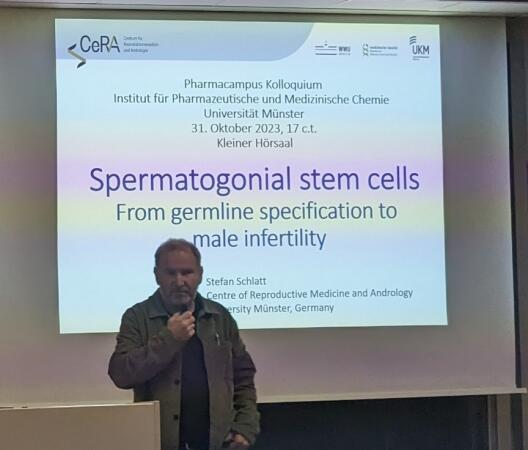
At the PharmaCampus-Kolloquium on the 31st of October 2023 we were honoured to welcome Prof. Dr. Stefan Schlatt from the Centre of Reproductive Medicine and Andrology of the University of Münster as our speaker.
The topic of his talk concerned spermatogonial stem cells and their role in germ line specification and male infertility. During the talk, Prof. Schlatt elaborated on the evolution of male germ cells throughout different animal kingdoms and highlighted aspects of hormonal regulation of spermatogenesis. Prof. Schlatt explained the genesis of these stem cells and their importance for male reproductive cell function and diseases like testicular cancer. Furthermore, he described recent advantages in the creation of human embryo-like structures derived from stem cells without the prior fusion of sperm and egg cell and noted the ethical implications that come with these scientific findings.
The colloquium ended with an animated discussion. We would like to thank Prof. Schlatt for sharing his research insights with us.

At the PharmaCampus-Kolloquium on the 6th of June 2023 we were pleased to have Dr. Jörg Lippert from the Pharmacometrics – Modeling & Simulations department of the Bayer AG as our speaker. Dr. Lippert lectured about the impact of machine learning based modeling in today’s healthcare applications. Dr. Lippert proceeded to provide various examples of these approaches, such as (among others) the development of a neural network for the prediction of efficacious dose-combinations for a clinical trial, as well as the use of natural language processing (NLP) models to analyze plain-text notes of physicians and healthcare providers in heart failure. With the aforementioned method, it was possible to perform cluster analysis to identify subpopulations among these patients and to derive guidance to improve future therapy in this area. However, Dr. Lippert also elaborated on potential limitations of these models. He explained that the major problem in machine-learning applications is the low quantity and oftentimes heterogeneity of the available data. This holds especially true for complex biological systems which are typical in healthcare environments. He explained that, in order to derive a meaningful model, there is an important prerequisite. Ultimately, the complexity (dimension) of the approached problem must match with the number of data, or number of observations, respectively.
We would like to thank Dr. Lippert for sharing his significant insights into his work with us.
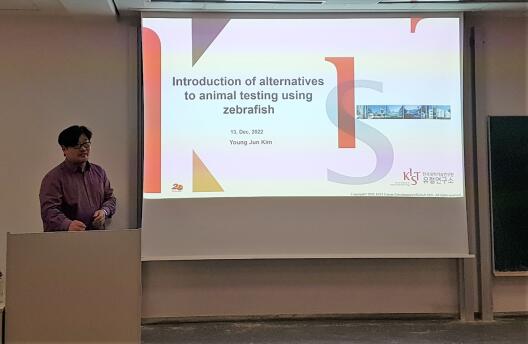
On the 13th of December 2022, we were honoured to have not only one but two speakers from the Korean Institute of Science and Technology (KIST) Europe in Saarbrücken, Dr. Young Jun Kim and Dr. Changseon Ryu.
In the first talk, Dr. Young Jun Kim gave insights into efforts to develop alternatives to animal testing to study the impact of environmental toxins and drugs pursued at the KIST Europe. He elaborated on several methods achieving this goal, such as using zebrafish embryos up to five days post-fertilization as a surrogate model. Furthermore, a three-dimensional zebrafish hepatocyte culture model was developed in his group to screen chemicals for potential hepatic toxicity. Moreover, Dr. Kim highlighted that connecting events on the molecular level, such as aromatase inhibition in reproductive toxicity, with detrimental outcomes on organism responses for environment and humans, such as specific organ or aquatic toxicity, are helpful in reducing the need for animal testing. As Dr. Kim emphasized, all these methods, combined with computational support, converge to establish and validate alternatives to animal testing in a unified toxicology evaluation platform.
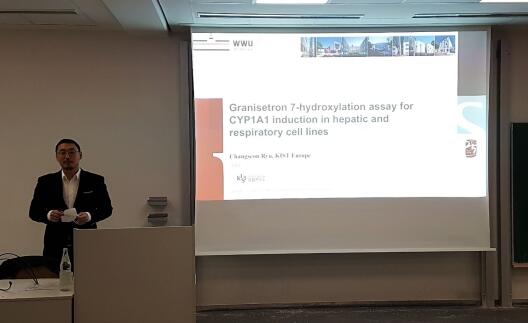
In the second lecture of the PharmaCampus-Kolloquium, Dr. Changseon Ryu spoke about a granisetron 7-hydroxylation assay for CYP1A1 induction in hepatic and pulmonary cell lines. His talk started with a brief introduction of the general metabolic pathway of chemicals conducted by cytochrome P450 enzymes in the liver. In the course of his talk, he presented the details of the assay and how an isoform selective metabolism can be assessed. Dr. Ryu explained that the CYP1A1 isoform is relevant for the metabolism of environmental toxins such as diesel particulate matter. However, to date it is not generally recognized as being involved in drug metabolism. Nonetheless, a drug such as granisetron shows high selectivity for CYP1A1. As a conclusion, he stated that the impact of CYP isoforms such as CYP1A1 as well as the extrahepatic metabolism of drugs and chemicals should be further studied to achieve an extensive risk assessment.
Both talks ended with a discussion round in which the speakers further illustrated their findings and answered questions from the audience. We would like to thank both speakers for sharing their research with us and giving us insights into assessing toxicological questions from the perspective of environmental scientists.
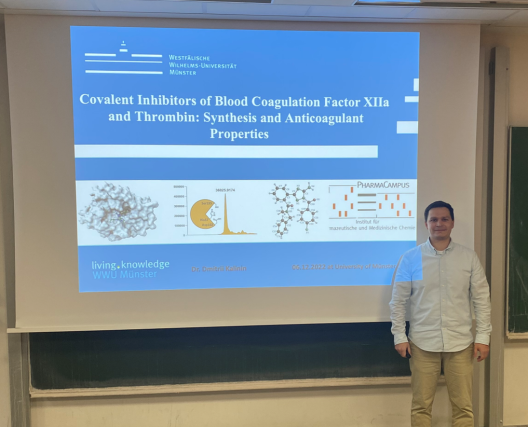
On Tuesday, the 6th of December 2022, we welcomed Dr. Dmitrii Kalinin from the Institute of Pharmacy and Medicinal Chemistry of the WWU as a speaker for the PharmaCampus-Kolloquium.
In his lecture he presented the discovery and development of covalent inhibitors of blood coagulation factor XIIa and thrombin and elaborated on the synthesis and anticoagulant properties of these novel chemical entities developed in his research group. At the beginning of his talk, Dr. Kalinin emphasized the therapeutical need in todays’ anticoagulant therapy. All classes of current market‑authorized drugs employed for this indication show the potential side effect of internal bleedings. Ultimately, these adverse events are inherent to these drugs due to their intervention point within the haemostasis process. Thrombosis itself is a major cause for death resulting from thrombosis-related events such as pulmonary edema, as well as heart and ischemic strokes. However, FXIIa inhibitors would potentially enable the prevention of thrombosis without influencing the haemostasis. In the further course of his talk, Dr. Kalinin illustrated the optimization of lead structures with an aminotriazole scaffold to ultimately result in the synthesis of compounds with low nanomolar potency. Furthermore, he shared insights about their structure‑activity‑relationships and elucidated their mechanism of action.
The colloquium ended with an animated discussion in which Dr. Kalinin answered the audience’s questions and explained future prospects of his research. We would like to thank Dr. Kalinin for giving us impressive insights into his work.
On Tuesday, the 31st of May 2022, we were honoured to welcome Prof. Dr. Laura Mercolini from the Department of Pharmacy and Biotechnology of the University of Bologna as a guest speaker. After a brief introduction about the long history and rich cultural heritage of the city of Bologna and its university, she spoke about methods to quantify drugs from biological samples obtained from small sample volumes. Prof. Mercolini gave an overview of the research topics in her lab, consisting of Therapeutic Drug Monitoring (TDM), research on drugs of abuse and antidoping analysis. Furthermore, she also highlighted the key points of the future in bioanalysis, which ultimately all point to favour the reduction of sample volumes. One of the major challenges of establishing methods of reliable quantitation of drugs in small sample volumes of 100 µl and less, is ensuring their homogeneity. In the last years there have been several developments, which have been shown to be capable of overcoming this hurdle even for different biological fluids, such as volumetric absorptive microsampling (VAMS) and the Hemapen. Apart from this problem, Prof. Mercolini also called attention to another challenge in small sample analysis. As the sample volume decreases, analytical methods of higher sensitivity need to be employed. She illustrated, that the most common solution for this issue is mass spectrometry. The symposium ended with a lively discussion in which Prof. Mercolini further elaborated on the audience’s questions and the research in her lab. We would like to thank her again for coming to Münster and giving us insights into her work.
Dr. Michael Schulte from Merck was very kind to follow our invitation for a talk within the framework of the PharmaCampus-Kolloquium on the 24th of May 2022. We were glad for being able to welcome him personally in Münster. The topic was about quinine, a drug with a history of now 390 years. He elaborated on the history of malaria, the disease for which quinine was developed as a remedy, and highlighted several anecdotes in both the history of the disease and quinine as the drug of choice for its therapy. Furthermore, Dr. Schulte illustrated, that china bark, or quinine respectively, was at times during its long career used as a powerful political tool and was also subject to financial speculation. All in all, it was clear that Dr. Schulte did an impressive and extensive research on the historical facts and details. The talk was followed by a vivid discussion in which he answered questions of the audience. We want to thank Dr. Schulte again for coming to Münster and holding this colloquium.
On Tuesday, the 18th of May 2021, we were honored to welcome Dr. Julia Schlereth from BioNTech as a guest speaker at our PharmaCampus Colloquium. More than 250 participants listened to her talk about the development and manufacturing of BioNTech’s Covid 19 vaccine, as it is a very hot topic worldwide. Dr. Schlereth gave a brief introduction about BioNTech’s structure and philosophy as a company and went further with various application fields of their mRNA technology platform. She gave an insight into the mRNA formats BioNTech is considering for different therapeutic areas, as well as a range of lipid formulations the company has developed to suit the demands in drug delivery. She then proceeded to provide an overview about the course of Project “Lightspeed”, which ultimately enabled the development and market authorization of the first Covid-19 vaccine. Throughout the talk, Dr. Schlereth illustrated aspects of mRNA manufacturing and analysis and highlighted the adaptability of the mRNA-based vaccine approach e.g., in terms of Coronavirus mutations. The colloquium ended with an animated discussion in which Dr. Schlereth answered further questions from the audience. We would like to thank Dr. Schlereth again for her talk and wish her well for her future work at BioNTech.
On Tuesday, 27th of April 2021, we were very pleased to have Prof. Dr. Seraphine Wegner from the Institute for Physiological Chemistry and Pathobiochemistry, WWU Münster as a speaker in our virtual PharmaCampus Colloquium. Prof. Wegner started her talk by introducing the concept of bottom-up synthetic biology and highlighting the spatial and temporal regulation of essential features of living systems. Consequently, she presented examples of different strategies developed in her lab to achieve the spatiotemporal control over cell adhesions in synthetic cells decorated with photoswitchable proteins using light as stimulus. These included light-guided surface adhesion and motility of giant unilamellar vesicles (GUVs), light-controlled chemical communication between sender and receiver GUVs and multi-stimuli-sensitive adhesion module. She further emphasized some of the possible translational applications of the developed light-controlled adhesion using synthetic cells as well as bacterial and mammalian cells. At the end of her talk, a scientific discussion took place in which Prof. Wegner answered the questions she received from the audience. We would like to thank Prof. Wegner for her inspiring talk.
On Tuesday, the 26th of January 2021 we were honoured to welcome Prof. Dr. Sergey Krylov from the department of Chemistry of York University, Toronto, Canada as a guest speaker. In his talk, Prof. Krylov outlined the analytical challenges of DNA-encoded library (DEL) technologies for the identification of inhibitors and potential drugs, highlighting various steps that can be improved in the current standard procedures of DEL hit identification. His talk was thereby focused on addressing the following questions: How can enrichment of potential binders using this technology be improved? How can better hit synthesis and particularly subsequent purification be achieved? And lastly, how to enhance the accuracy of Kd and koff determination for the identified hits. To solve all these problems, he discussed solution approaches ranging from the implementation of homogeneous partitioning by capillary electrophoresis for refining binder selection to establishing a continuous-flow system for hit synthesis and purification. As for the determination of dissociation constant of a ligand-protein complex, his research group developed a new method relying on kinetic separation coupled with mass spectrometric (MS) detection.
The symposium ended with a vivid and fruitful discussion in which Prof. Krylov further elaborated on his findings. We would like to thank Prof. Krylov for giving us insights into some of his research work and are looking forward to welcoming him in Münster during his sabbatical.
We were very pleased to have Prof. Dr. Eric Beitz from the Pharmaceutical and Medicinal Chemistry Department, University of Kiel as our virtual guest speaker on Tuesday, the 8th of December 2020. In his talk, Prof. Beitz shared with us interesting work from his lab aiming at developing novel anti-malarial compounds by inhibiting the Plasmodium lactate/H+ transporter. The Formate-Nitrite Transporter of the parasite Plasmodium falciparum (PfFNT) was identified recently in the lab of Prof. Beitz as the only known lactate transporter in the parasite which is vital for its survival in infected erythrocytes. Prof Beitz presented some of the data characterizing this novel transporter regarding substrate selectivity and transport mechanism. Furthermore, he highlighted the work done to study the druggability of this novel target leading to the discovery of PH267.meta, a nanomolar inhibitor of PfFNT. In the final part of his talk, Prof Beitz showed promising data revealing the strong activity of PH267.meta against all human-pathogenic Plasmodium species and indicating that PfFNT inhibition may constitute a new effective mode of action against malaria and possibly other protozoal infections. We would like to thank Prof. Beitz for his interesting talk.
On the 17th of November, we had the first talk of the PharmaCampus-Kolloquium since the beginning of the corona pandemic. We were honoured to welcome Prof. Dr. Joseph Ciccolini from the Center for Research on Cancer of the University of Marseille as a speaker. Due to current corona regulations, it was not possible to welcome Prof. Ciccolini personally in Münster, thus the talk was held via Zoom. In his talk, Prof. Ciccolini discussed the topic of pharmacokinetic/pharmacodynamic (PK/PD) relationships for immune checkpoint inhibitors in cancer therapy. He indicated that PK/PD relationships for this class of drugs are not clear cut. Although at first-glance, the dosing for these drugs seem to be of minor importance, as certain clinical outcomes remain unaffected over large variations in dosing, Prof. Ciccolini highlighted that their administration schedule in combination with other drugs is often of major importance for therapeutic success. While combinational strategies are considered to be the future of immunotherapy in oncology, it also leads to an increasing complexity in the design of suitable therapeutic strategies in terms of order and timing of the drugs chosen for treatment. Rational approaches such as the employment of mathematical models and simulations, and the consideration of pharmacometric parameters can potentially serve as a valuable aide. Application areas for these models include the design of clinical trials, optimization of dosing regimens and the reduction of treatment costs by considering aspects such as drug metabolism. Prof. Ciccolini made clear that further knowledge regarding the specific site of action of these drugs remains to be obtained, as well as critical pharmacokinetic and pharmacodynamic parameters to be identified, to enable a more rational approach in the therapy with these drugs.
We would like to thank Prof. Ciccolini for his valuable insights into this field and hope that he will be able to visit us for his next talk in Münster.
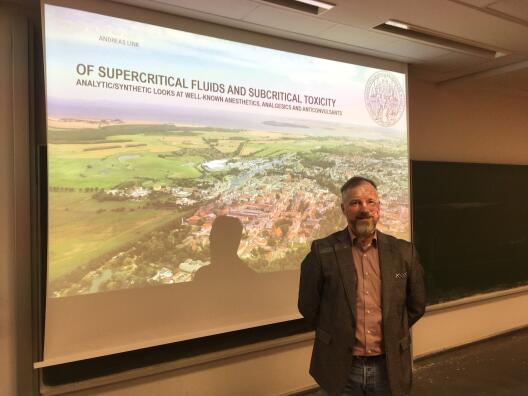
On Tuesday, the 28th of January 2020 we had Prof. Dr. Andreas Link from the Pharmaceutical/Medicinal Chemistry Department, Greifswald University as a guest speaker. In his talk, Prof. Link highlighted the role of metabolites as underlying causes for the toxicity associated with the analgesic drug, Flupiritine and the structurally similar anticonvulsant drug, retigabin leading eventually to their removal from the market. To enable the development of effective follow-up compounds with improved toxicity profile, he presented his approach to study not only the stucture-activity relationships but also the structure-metabolism relationships of these compounds using the so-called supercritical fluid chromatography. In the last part of his talk, Prof Link presented a supercritical fluid extraction method coupled to quadrupole MS detection successfully developed in his lab to separate and quantify ketamine and its metabolites from urine samples. We would like to thank Prof. Link for his talk which triggered a fruitful scientific discussion with the audience thereafter.
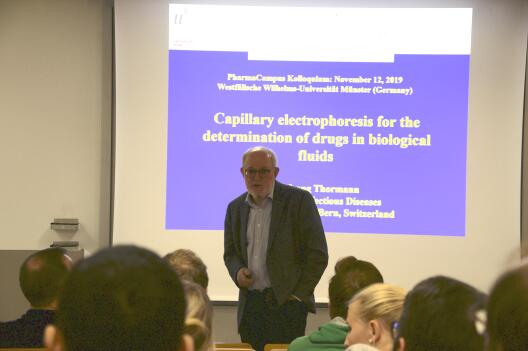
In seinem sehr lebendigen Vortrag „Capillary electrophoresis for the determination of drugs in biological fluids“ gab Prof. Thormann den Zuhörern einen anschaulichen Überblick über die Andwendungsmöglichkeiten der Kapillarelektrophorese. Nach Erläuterung der physikalischen Grundlagen und des Trennprinzips ging er vor allem auf die Trennung chiraler Komponenten ein. Anhand von Fallbeispielen konnte Prof. Thormann überzeugend darlegen, dass die Kapillarelektrophorese eine effektive und ökonomische Methode der instrumentellen Analytik darstellt, die insbesondere in der klinischen und forensischen Toxikologie und dem therapeutischen Drug-Monitoring eingesetzt werden kann. So ging er beispielsweise auf das Monitoring des Anti-Epileptikums Lamotrigin und des Antimykotikums Fluocytosin aus Patientenseren näher ein. Wir danken Herrn Prof. Thorman herzlich für die sehr umfassende Darstellung der Methodik und ihrer Anwendung in der pharmazeutischen Analytik.
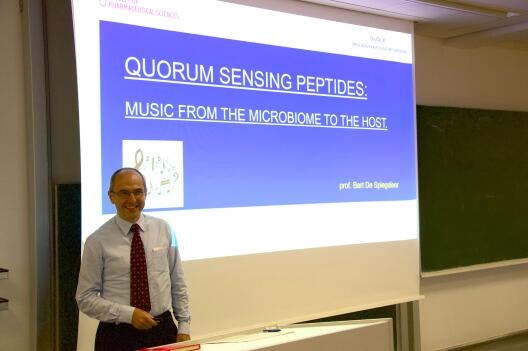
Am Dienstag, den 18.7.2019 hatten wir Prof. Bart de Spiegeleer vom Department of Pharmaceutical Analysis der Universität Ghent zu Gast. Er berichtete über den Cross Talk zwischen bakteriellen Pathogenen und ihren Wirtsorganismen. Innerhalb einer Population können Bakterien mit Hilfe des sog. Quorum Sensings miteinander kommunizieren und sich in Bezug auf eine bestimmte Eigenschaft synchronisieren. Dafür werden auch Peptide als Signalmoleküle eingesetzt, die als Quorum Sensing Peptides bezeichnet werden. Die Untersuchungen der Gruppe um Bart de Spiegeleer haben nun gezeigt, dass diese Peptide auch Zellen des Wirtes beeinflussen, in dem sie über Wirts-eigene Signaltransduktionswege zur Ausdifferenzierung von Muskelzellen, zum Transport über die Blut-Hirn-Schranke und zur Auslösung neoplastischer Erkrankungen führen können. Ein solcher Pathogen-Wirt-Crosstalk erscheint durchaus plausibel, wenn man den langen Zeitraum der Interaktion beider Organismengruppen miteinander in Betracht zieht. Um den Zugang zu diesem noch recht jungen Forschungsgebiet zu erleichtern, hat die Gruppe eine Datenbank mit den bekannten Quorum Sensing Peptides erstellt (Quorumpeps Database), in denen man z.B. nach Ähnlichkeiten zu Signaltransduktionsmolekülen des Wirtes suchen kann. Wir danken Bart de Spiegeleer für den sehr interessanten Einblick in ein neues Forschungsgebiet und die lebhafte Diskussion im Anschluss an seinen Vortrag.
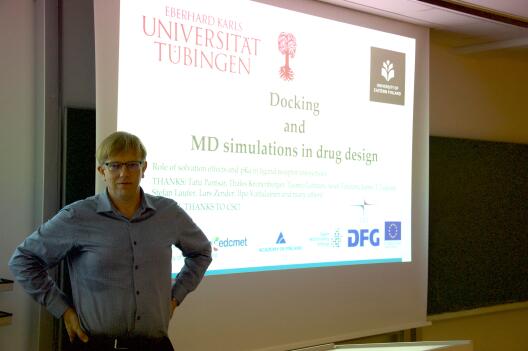
Am Dienstag, den 18.06.2019 berichtete Prof. Dr. Antti Poso der Unversity of Eastern Finland über die Anwendung der molekularen Modellierung in der Wirkstoffforschung. Titel seines Vortrages war “Docking and MD simulations in drug design". Im Anschluss an den anschaulichen Vortrag gab es eine rege Diskussion, die bei der Nachsitzung im Gasthaus Leve vertieft wurde.
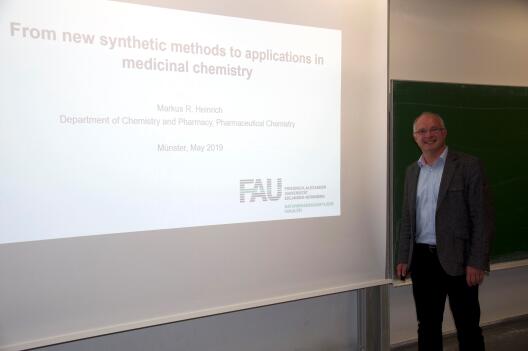
Am Dienstag, den 28.05.2019 berichtete Prof. Dr. Markus Heinrich vom Department Chemie und Pharmazie der Friedrich-Alexander-Universität Erlangen-Nürnberg über neue, insbesondere durch pfiffige Ansätze der Radikalchemie getriebene Methoden zur Synthese von Wirkstoffen und Reportermolekülen. Der Gruppe um Markus Heinrich ist es gelungen mit diesen Methoden hochpotente und Subtyp-spezifische Dopamin D4 Rezeptor Liganden und muskarinische M3 Rezeptor Liganden zu synthetisieren. Die innovativen Synthesemethoden wurden mit großem Interesse aufgenommen und im Anschluss an den Vortrag intensiv diskutiert.
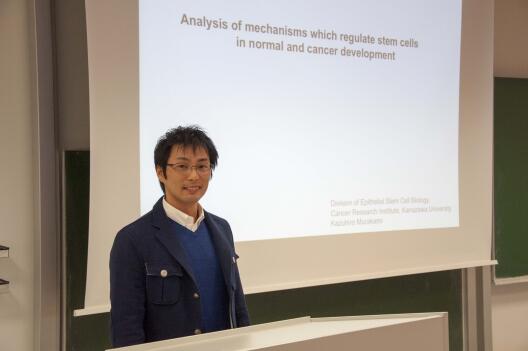
JunProf. Dr. Kazuhiro Murakami vom Cancer Research Institut der Kanazawa Universität Japan, berichtete am Donnerstag, den 7. Februar im PharmaCampus Kolloquiums über Forschungsarbeiten zur Entwicklung von Stammzellen.
Insbesondere geht es ihm darum, wie sich pluripotente Stammzellen, aus ihrer normalen Funktion für die Entwicklung und die Gewebshomöostase heraus zu Tumorstammzellen entwickeln und durch welche zellulären Faktoren sich die beiden Stammzellpopulation unterscheiden lassen. Dabei hat er im Maus-Modell eine Reihe von Transkriptionsfaktoren identifiziert, die als Target für eine Therapie bei gastrointestinalen Tumoren in Frage kommen könnten. Wir danken Kazuhiro Murakami für seinen Besuch am PharmaCampus und den spannenden Vortrag.
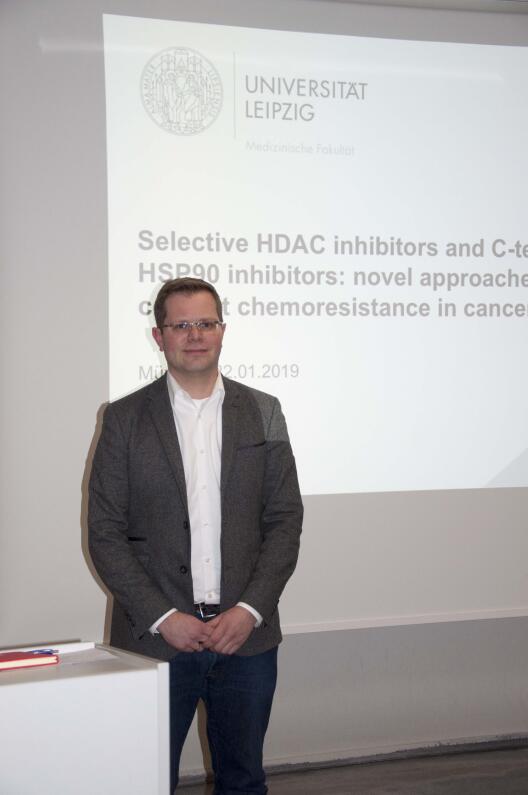
Am Dienstag, den 22.01.2019 berichtete Prof. Dr. Finn K. Hansen vom Institut für Pharmazie der Universität Leipzig im Rahmen des PharmaCampus Kolloquiums über seine jüngsten Untersuchungen zur Entwicklung neuer Antitumorwirkstoffe.
Im ersten Teil seines Vortrages ging er auf die Synthese neuer Histone Deacetylase (HDACs) Inhibitoren ein, sowie auf Strategien, diese Substanzen selektiver zu machen. Dabei wurden sehr potente Wirkstoffe gefunden, die im nächsten Schritt dazu dienen sollen, mit Hilfe eines Multitargetansatzes sehr effektive Antititumormittel zu entwickeln. Im zweiten Teil seines Vortrages ging Finn Hansen auf eine neue Gruppe von Peptidomimetika ein, die sogenannten a-Aminoxy-Peptide. Mit Derivaten dieser a-Aminoxy-Peptide, die in seiner Arbeitsgruppe synthetisiert wurden, konnte die Dimerisierung und damit die Aktivität des Chaperones HSP90, das in vielen Tumorgeweben überexprimiert ist, wirksam gehemmt werden. Die beste Substanz, Aminoxyrone, zeigte in-vivo Aktivität und war auch wirksam gegen Imatinib-resitente humane Leukämiezellen, wie in dem hochrangigen Fachjournal Blood (2018, 132: 307-320) kürzlich veröffentlicht. Im Anschluss an den anschaulichen Vortrag gab es eine rege Diskussion, die bei der Nachsitzung im Gasthaus Leve vertieft wurde.
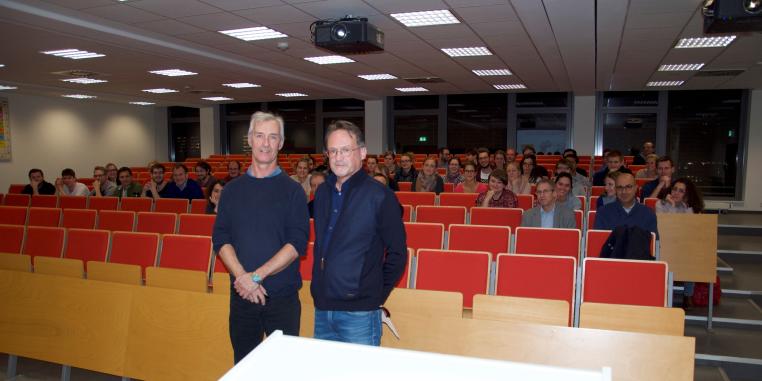
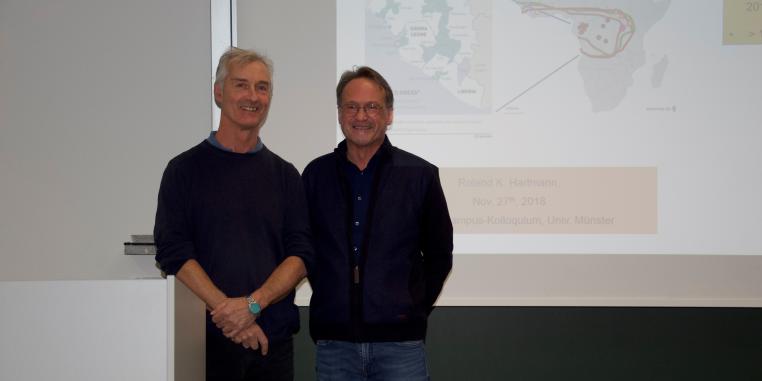
Am 27.11.2018 trug Herr Dr. Roland Hartmann von der Universität Marburg im Rahmen des PharmaCampus-Kolloquiums vor.
Roland Hartmann berichtete in seinem Vortrag im Rahmen des PharmaCampus Kolloquiums über neue Erkenntnis zur Replikation und Transkription bei dem RNA- Virus Ebola. Insbesondere wurde der Mechanismus, der zum Umschalten von Replikation auf Transkription führt, betrachtet und welche regulatorischen Elemente auf RNA-Ebene eine Rolle spielen könnten. Im zweiten Teil des Vortrags wurde auf die Bindung des Naturstoffs Sylvestrol an den Translationsinitiation Faktor-4A (eIF4A) eingegangen. Diese Bindung, die spezifisch die Virusvermehrung in eukaryotischen Zellen blockiert, könnte ein Hinweis für einen neuen therapeutischen Ansatz Infektion mit dem Ebola Virus, aber auch bei anderen Virusinfekten, die z.B. durch Corona- und Picornaviren ausgelöst werden, sein. Wir danken Herrn Hartmann für die interessanten Einblicke zu Forschung auf dem Gebiet der Entwicklung antiviraler Wirkstoffe, die einen gut gefüllten Hörsaal 1 im PharmaCampus als Auditorium hatten. Es war der erste Vortrag im Rahmen des neuen PharmaCampus Kolloquiums.


